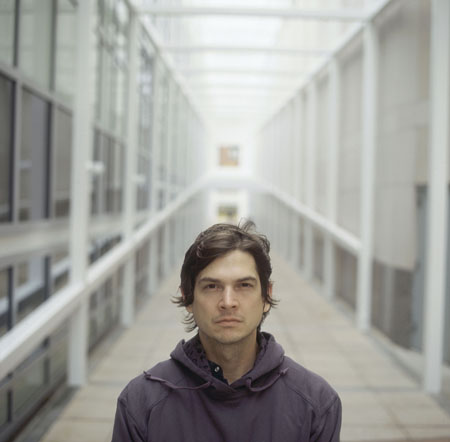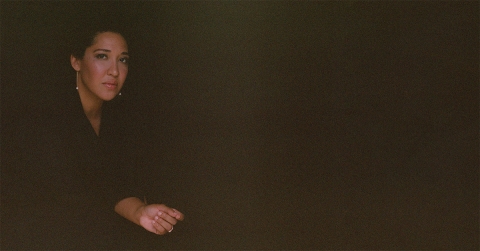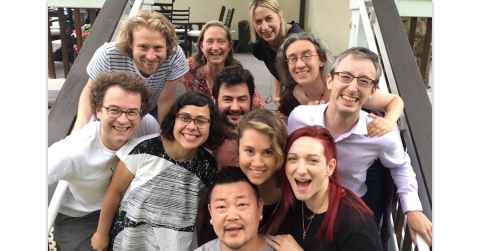On October 25 and 26, Glenn Kotche and Kronos Quartet premiered Glenn's new piece for quartet and percussion, Anomaly, at the San Francisco Jazz Festival. Last month, we brought you the notes Glenn wrote for the program, in which he describes the very personal inspiration for the new work. Here, in a note he's written exclusively for the Nonesuch Journal, Glenn shares some insights into the process of composing, rehearsing, and performing a brand new piece during what was already a year of non-stop touring for Wilco, and for Kronos as well.
On October 25 and 26, Glenn Kotche and Kronos Quartet premiered Glenn's new piece for quartet and percussion, Anomaly, at the San Francisco Jazz Festival. Last month, we brought you the notes Glenn wrote for the program, in which he describes the very personal inspiration for the new work. Here, in a note he's written exclusively for the Nonesuch Journal, Glenn shares some insights into the process of composing, rehearsing, and performing a brand new piece during what was already a year of non-stop touring for Wilco, and for Kronos as well:
I first got the idea to write a string quartet after seeing Kronos perform The Cusp of Magic by Terry Riley at Zankel Hall in early 2006. As I sat in the audience watching the performance, I was struck at how the four parts of the ensemble interacted and played off of each other. It made me think of the relationships of my limbs when playing drum set. I thought it would be really interesting to explore that kind of interaction in a composition-treating the quartet as a kind of drum set. After the show, Melissa Cusick, the Nonesuch publicist, introduced me to David Harrington, Hank Dutt, and Kronos’s longtime manager, Janet Cowperthwaite.
In the next few weeks, I started to come up with ideas of how to approach a piece like this. I ultimately decided it might be cool to also write a fifth optional part for drum set. A few months later, while I was on tour in Canada with Wilco, David called me. He was a fan of my solo percussion record, Mobile, which had Nonesuch released earlier in the year. He asked me if I would write a piece for them with an optional fifth percussion part. Obviously I was excited to see that he had the exact same idea and thought it was a good enough sign for me to go through with it—even though I had never previously written outside of the realm of percussion. The piece would be commissioned by Priscilla Stoyanof, a Kronos board member, in honor of her late husband—the longtime Kronos board member and supporter Angel Stoyanof.
The only guidelines that David gave me were for the piece to be vital, beautiful, and wonderful. He also said that it should be rhythmically vibrant and only as long or short as it needs to be. I started to listen to some of the back Kronos catalog that I wasn't as familiar with. I just wanted to get a general idea of what kind of things that they've tackled in the past in an attempt to keep my piece fresh for them. I began listening in particular to George Crumb’s Black Angels quite a bit, as that was the piece that served as the impetus for David to form Kronos. Black Angels gave me the idea to explore all sides of my drumset playing translated to strings, whereas I had been thinking mainly in terms of rhythmic possibilities. This meant also including representations of the coloristic and textural sides of my playing. I've always been a curious musician and did a lot of experimenting with percussive sounds with no concern for rhythm when I moved back to Chicago after college. That's when I started playing with Jim O'Rourke and Darin Gray and began to improvise in free settings. Having that aspect to my playing is one of the reasons why Jeff Tweedy asked me to join Wilco in the first place. It was at a time when Wilco was changing direction, and I was asked to include all kinds of percussive colors in making Yankee Hotel Foxtrot.
I started writing fragments soon after I spoke with David. I continued writing disparate ideas throughout the second half of the year while Wilco was touring and recording. I had the melodic motif written early on but ran into a wall in early fall. I remember clearly being frustrated with the progress. To take a breather, I went to the basement to just play drums for a little while. It was then that the first three movements just came to me. These were written on the drums but would be expanded upon and orchestrated for the quartet. I wrote the ideas frantically and the skeleton for the first half of the piece was done that day.
Things came easily after this and most of the final structuring of the piece came at nights and in the mornings while I was involved in the Wilco Sky Blue Sky final recording sessions during the day. That was in November 2006. I had most of the piece done by the time my wife Miiri and I went to Guatemala, just after the New Year, to do humanitarian work for the University of Illinois–Chicago chapter of Engineers Without Borders, of which Miiri was the president.
While in Guatemala, I unfortunately got ill for a couple of days and checked into a hotel to recuperate near the village where we were working. It was in that very rugged hotel room that I finished the last remaining elements of the piece—the drum parts! The piece was finally done and turned into Kronos in late January 2007.
This year has been the busiest touring year I've ever experienced, due to the release of Sky Blue Sky. My breaks were few and brief. Not enough quality time to really dig in and learn my drum parts for Anomaly. Many of my parts were purposefully written a bit over my head, so to speak. I wanted to challenge myself, so I wrote what I heard for the percussion parts without worrying too much about whether I was actually capable of playing them! Luckily there were all within my reach, after many hours of practice on a small thrown together practice kit that I kept in the bays of the Wilco band bus. I would get some time on it on show days, when it would be set up in a separate dressing room to not bother my band mates too much. I would also check out meeting conference rooms at the hotels we stayed at on any days off. I put sheets and towels on the instruments so they wouldn't be too loud, and I even got away with practicing a whole day in my hotel room once—amazingly with no complaints.
I went to San Francisco during a brief touring break about two weeks before the premiere to go over the piece with Kronos. I brought all of the percussion instruments with me and we began to work out the more rhythmically complex aspects of the piece (movement two is really demanding on the violins). Everything seemed like it went well, and the quartet was able to get a better picture of the overall architecture and demands of the piece. The Sonos hand-bell choir from San Francisco was kind enough to lend the necessary hand bells that would be required in two of the movements. It was great to finally meet everyone in the Kronos organization, a wonderful and talented group of people—and a joy to be associated with.
The week of the premiere, I came to town a few days early so we could do the final rehearsals and get everything together before the preview—a party for the people who helped commission the piece. Our first rehearsal was Monday afternoon; things went slowly. Kronos had been touring, as I had been, in the time since we had last played. They were also rehearsing in the mornings with Tom Waits for the Bridge School Benefit concert that they'd be playing following our two shows at the SF Jazz Festival. It took some time to for everyone to get reoriented with the uncommon percussion instruments that they’d have to play. It also took some time to work out the complex second movement. We ended the rehearsal only having gotten through half of the piece. I was definitely feeling a bit concerned afterwards that I had written a piece that was too detailed and complex to be read through and played; this was a piece that really needed to be rehearsed. There are a lot of changes that each player needs to make between instruments and implements. I was assured though that things would come together in time—this is Kronos Quartet we're dealing with! They've faced some ridiculously challenging music and situations in the past and are all absurdly talented individuals.
Tuesday's rehearsal went much better. We were able to do a couple of run-throughs. All the instrument changes were mapped out and cues assigned. My nerves were considerably calmer after this rehearsal.
Wednesday was the preview party at the Swedish American Hall above Café du Nord, where I had played a solo show earlier in year with my band-mate Nels Cline. The preview was invite-only for friends and contributors to the Angel Stoyanof Commission Fund. It was catered by the superb restaurant Nopa. After a brief program from Kronos of some great music, including a version of one of my favorite songs, “Marquee Moon,” by Television, it was time for me to join them on stage. It ended up being the best that we had played the piece up to that time. The reception from the audience was very positive, which was a huge relief for me. I felt a certain responsibility to compose something that was not only new ground for Kronos and myself but also something that honored the memories of Angel Stoyanof and my Uncle Eddie, who inspired the piece. I wanted it to be enjoyed as well as appreciated.
Thursday was the world premiere at the beautiful Herbst Theater as part of the SF Jazz festival. (Interesting fact: the Herbst was the location of the charter meeting of the UN.) After setup, sound check, and rehearsing a few changes that I made in the drum parts, everything was ready to go.
Both nights, Kronos put on a wonderful and eclectic program. The first half included pieces by Amon Tobin, John Zorn, Raymond Scott, a beautiful piece by Narayan, and Cerulean Sweet III by Walter Kitundu. Walter is an instrument builder and built some incredible hybrid string instrument/turntables for him and the members of Kronos to play. After intermission, the program started with "Marquee Moon." It then proceeded to a piece by Dohee Lee. She sang beautifully with the quartet on her piece drawn from traditional Korean music. Next came an arrangement of "Round Midnight" by Monk and then Anomaly. This was again the best we had played the piece up to that point. I felt great about the performance even though there were a couple of rough spots. One of those spots came when an Asian crash cymbal that John Sherba was required to play vibrated off of my drum riser and onto his violin! The damage turned out to be minimal, and though we didn’t know that at the time, John just went with it. A potentially performance-stopping moment avoided, thanks to his professionalism and dedication to the music. Again, the response from the audience was extremely positive.
The program was the same for Friday evening. I was really excited to play the piece one more time, as it seemed to be growing on everyone. This was again the best we had played it-no falling cymbals this time! A few of the last-minute musical changes worked really well, and it was finally at the place were I had been hearing it in my head for all of the months prior to the premier. It was a very gratifying and rewarding experience. I learned a lot about composing, rehearsing, and writing for strings. I learned things that can't be learned from a book but have to be learned by actually doing them. I still can't believe that Kronos Quartet actually played one of my pieces.
Most of all it was great for me to meet and get to know David, John, Hank, and Jeff; not to mention Larry, their head of production; and Scott, their sound technician. This also extended to Janet and everyone at the Kronos office, as well as the friends of the Stoyanofs. Everyone involved with them is super nice, down-to-earth, and very easy to get along with. Not always the case with people as talented as they are. Kronos has set an amazing example for any group or musician—their dedication to creating new works and constantly expanding the idea of what a string quartet is and is capable of is inspiring on so many levels.
I’m really looking forward to future performances of Anomaly in 2008.



